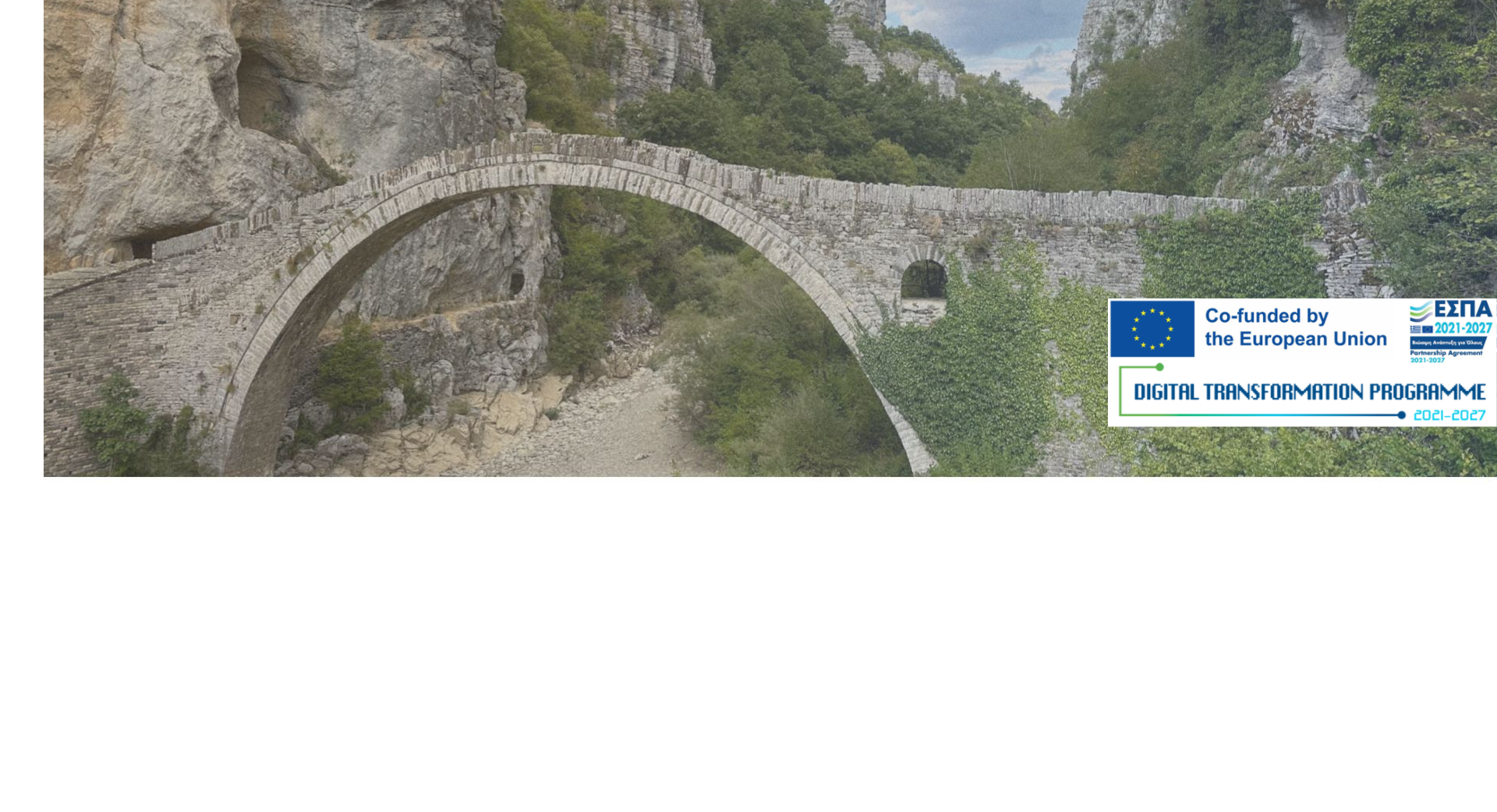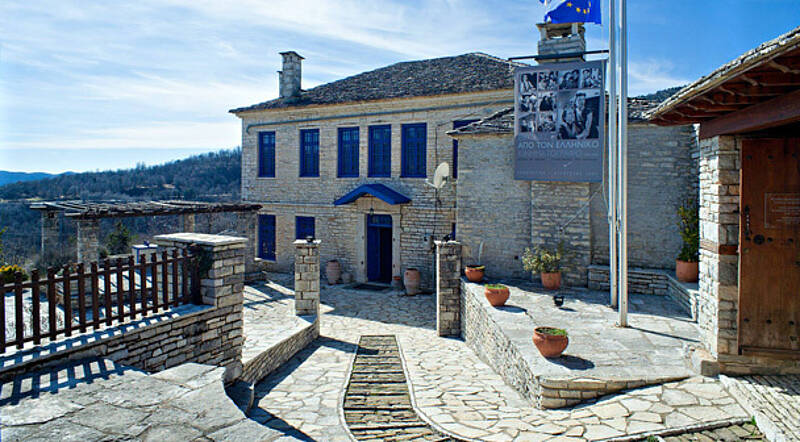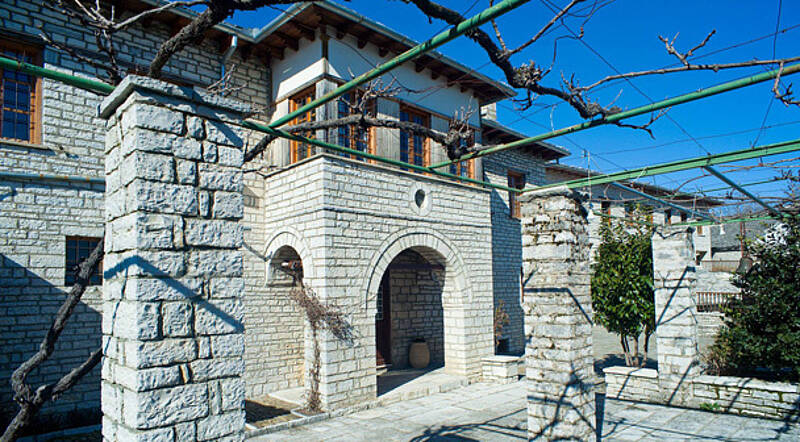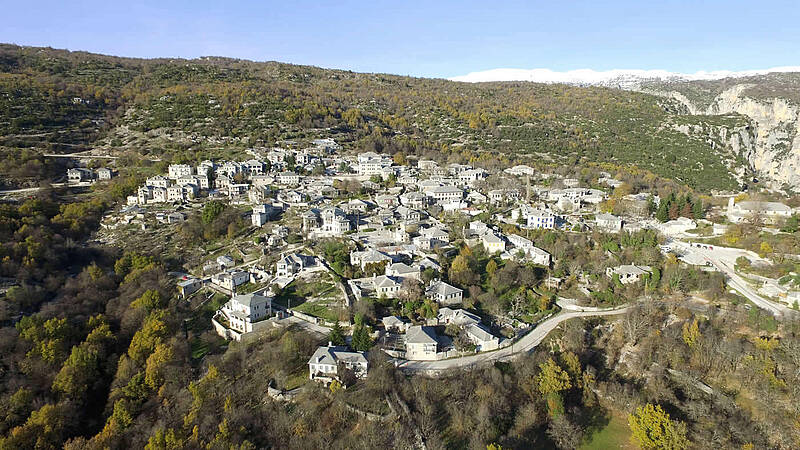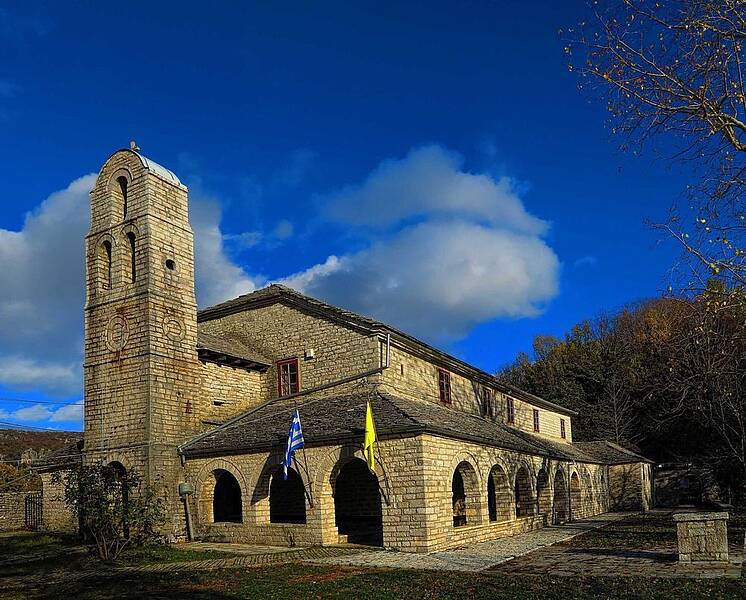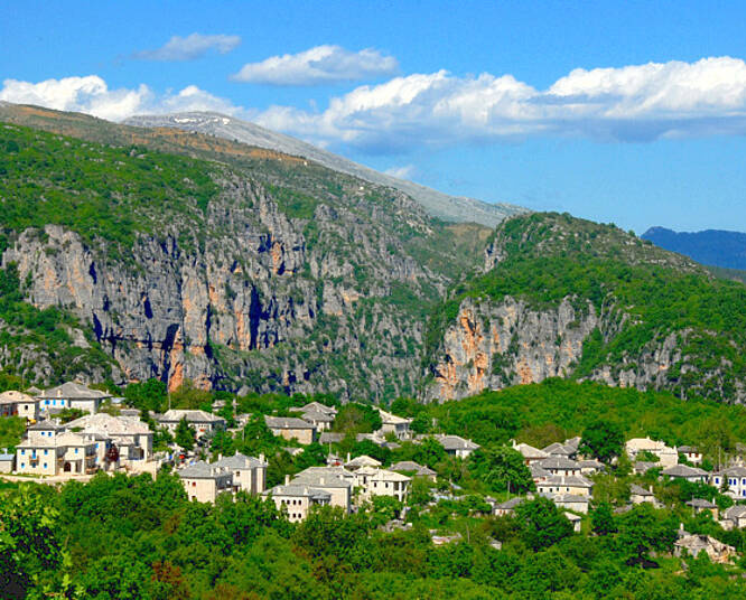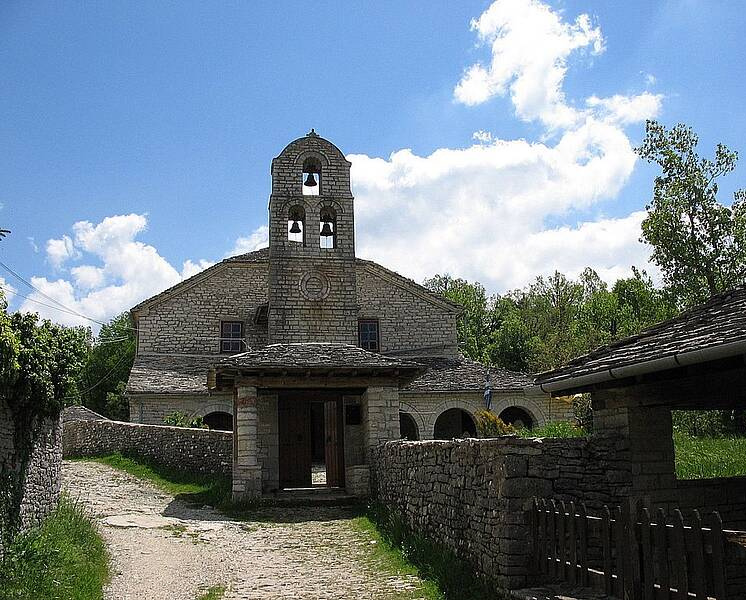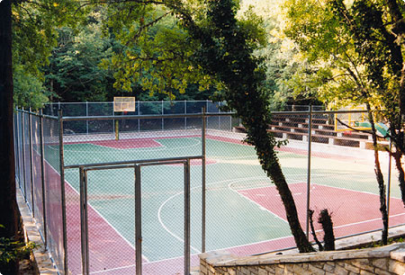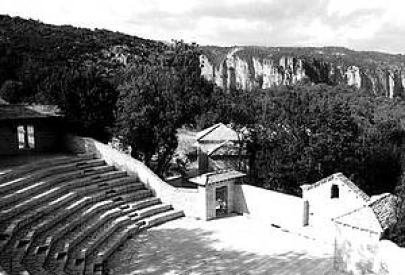``The land behind the mountain``
Zagorochoria is one of the most interesting regions of our country. Their imposing mountainous nature, with its rich forests and crystal clear rivers, are today adorned with 46 villages, famous for their natural beauty and their unique traditional architecture. In Monodendri, during the last 20 years, with the cooperation and active participation of the local population and the financial assistance of the state, as well as resources of the European Union and large public benefit institutions of our country, an integrated development intervention is successfully attempted, which makes Monodendri an important arm of cultural tourism of the whole of Epirus. This effort has already had a profound effect on the economy of the neighbouring villages and it is certain that in the coming years it will bear even greater fruit both in Monodendri and in the wider region (creation of new jobs, further upgrading of the natural and built environment, etc.). It should be also noted that Monodendri, for its performance in the proper design of its cultural infrastructure, received a special award in the Pan-European Competition ``Upgrading Villages 2000`` of the Austrian Argitole Organisation.
Monodendri
Monodendri, at an altitude of 1100 m, is one of the most beautiful and representative Zagorochoria. Along with the neighbouring Vitsa, it is an unparalleled residential complex that expresses the traditional architecture of Zagori and Epirus in general. Afterall, all Zagorochoria are beautiful, each with its own peculiarities.
Monodendri was built around 1360 AD. Between Vitsa and Monodendri, next to the public road, the oldest known settlement of Epirus, with two cemeteries, was discovered in 1965 (map position 1). The rich findings are exhibited in the Archaeological Museum of Ioannina. Monodendri has 7 churches and the oldest of them are: the monastery of Agia Paraskevi (map position 2) 1412 AD, Agios Minas (map position 3) 1625 AD, the monastery of Prophet Elias (map position 4) 1664 AD and the central church of Agios Athanasios (map position 5) 1801 AD.
Monodendri is the hometown of the great national benefactors, brothers Manthos and George Rizaris, who used their immense fortune, which they acquired in Russia, for the establishment of a foundation and through it, in 1844, the creation of the historical Ecclesiastical School of the same name in Athens. Its contribution to Orthodoxy and the education of the nation to this day is immense. The Rizarios Foundation also cares for the development of the birthplace of the Rizarios Brothers and the wider region of Zagoria.
From Monodendri also descended the “father of Greek agriculture” Spyros Hasiotis, the first mayor of Athens Ioannis Koniaris, the founder of pediatric science in our country Anastasios Zinnis, the great Hellenist Dimitrios Semitelos and other prominent men.



- The gorge of Vikos: The famous Vikos Gorge stretches for 12 kilometres and has been recorded in the Guinness Book of Records as the deepest in the world (1,350m is maximum height of the rocks from its bed). It is crossed by the Voidomatis tributary of the Aoos, forming natural landscapes of unparalleled beauty along the way.
From Monodendri, one can enjoy some of its most spectacular and exciting views from the following three wider locations.
- Monastery of Agia Paraskevi (map location 2). The route starts from the central square of Monodendri, has a length of 800 m and is crossed by an elaborate cobbled path. On the left side of the Monastrion one can find “The houses”, shelters of the locals during the Turkish-Albanian raids of the past centuries. Today’s remains: traces of wooden bridges, ruined walls with battlements and a chapel, from which the most daring descended into the gorge to carry water to the women and children trapped in the caves.
- Oxya (map position 6). The most impressive view of the gorge. The route starts from the upper square of Monodendri and consists of 6 kilometers of paved road, which passes through the unique Petrodasos (map position 7) with the mythical formations of giant slate rocks.
- Grounia (map position 8). This location can be reached by starting from the central square of Monodendri, behind the church of Agios Athanasios. This route, at the point where it meets the Open Air Amphitheatre of Monodendri “Angelos Kitsos”, also leads through a cobbled path, to the bed of the Vikos gorge (about an hour’s walk). The route within the gorge ends in the villages of Vikos and Papigo. One can enjoys impressive views of Vikos from the villages of Vikos, Vitsa, Vradeto, Kapesovo, Kipi, Koukouli, Papigo and Tsepelovo.



Niarchios Athletic Court
Built with the sponsorship of the Stavros S. Niarchos Foundation in an idyllic location next to the cobbled road to Agia Paraskevi of Vikos, the court has changing rooms, wooden platforms, basketball courts, etc. and is intended for basketball, volleyball, tennis and 5×5 football matches.
Open Air Theatre of Monodendri ``Angelos Kitsos``
The theatre is a masterpiece of stone construction, behind the main church of St. Athanasius. Starting from the central square of the village, one reaches the theatre by crossing a picturesque, green alley 300m long. With capacity of 2000 seats and comfortable dressing rooms, secretarial rooms, a warehouse for scenic material, etc, the theatre, which belongs to the Municipality of Central Zagori, was built with funding from the Interreg II Transnational Programme and is intended, among other things, for events of inter-Balkan scope.
In 2009, at an event organized by the Municipality of Central Zagori and the Rizarios Foundation, a naming ceremony was held for the “Angelos Kitsos Theatre” in honor of the late president of the R.E.S. Angelos Kitsos.
- Phone numbers in Monodendri: 26530 71382, 26530 71573
- Phone numbers in the Municipality of Zagori: 26533 60300, 26530 22536
- Phone numbers in Athens: 210 7219502, 210 7210661
Koukouli
An old mansion village with a history of more than 800 years, Koukouli, at an altitude of 850-900, with the old mansions, the stone-built houses of special Zagorian architecture, the paved cobbled streets and the traditional Epirus bridges, was established as a settlement around 1430 AD. It is located in central Zagori, near the southern end of the Vikos gorge. Its name is thought to derive from the very large stones (koukoules) found in the area, or from the possible earlier occupation of its inhabitants with sericulture.
Landmarks
Lazaridis Folklore Museum
A very important initiative of Rizarios is the establishment and operation of the Cultural Center “KOSTAS LAZARIDES”. It is housed in a traditional residence donated to Rizarios along with its botanical collections and other museum – archival material by the late Zagorios teacher, folklorist, naturalist and writer Kostas Lazaridis. It has been operating since August 1990 in Koukouli of Zagori, Ioannina.
There, the visitor and the student will discover historical letters, documents, old newspapers, folklore, unpublished texts and a rich library. In the Museum’s annexes there are samples of medicinal plants that thrive in the area and information about the miraculous profession of the Vicarians, a group of practitioners who made medicinal preparations (manjunias) from plants.
Church of the Assumption of the Virgin Mary (1788)
The Assumption of the Virgin Mary in Koukouli, a church in the basilica style, is an excellent example of Zagori architecture, with a wooden carved iconostasis and frescoes. According to the inscription at the western entrance, the present church was built in 1788, on the site where the church was built for the second time in 1630, on the foundations of the first small building of the holy church, at an undeclared date.
The Mansion of Plakidas
It is one of the most famous mansions of the region and a monument of tradition and architecture of the whole Zagori, with amazing frescoes that have been restored in 2002. It was built before 1830 and is the house where the great benefactor of the village, Eugene Plakidas (1855-1919) was born. The community of Koukouli, by its protocol of 27 August 1909, declared him a benefactor. With his money, the North side of the Church of Koukouliou was built in the year 1853. Along with his brother Andreas, they renovated the “Kalogeric” bridge , which ever since has been renamed as “Bridge of Plakidas”.
The old school with the three taps
Next to the church there is an impressive architectural building complex, which includes the chapel of Zoodochou, the old school, the cell and three fountains· the fountain of Basias – Manthos , the middle fountain and the fountain of Chatzis Vritsis which was built in 1758. Beside it, one can find the old school which was used as a schoolhouse until 1936.
The three-arched bridge ''Kalogeriko'' or Plakida
The three-arched bridge “Kalogeriko” or Plakida, built in 1814, is an exceptional monument of the art of bridges with its perfectly preserved curved lines.
Originally it was wooden, while the abbot of the monastery of Prophet Elias, who had a mill, built the present stone bridge and that is why it was named Kalogeriko. The second name “Plakida” was taken from the Koukouliotian lord Plakidas who repaired it twice. The bridge served mainly the shepherds of Koukouli and the inhabitants of the surrounding areas. In 1964 it was declared a historical preserved monument.
The bridge of Mr. Noutsos or Kokkorou
The stone arched bridge of Mr. Nutsos or Kokkoros was built in 1750. It is a typical example and an excellent work of traditional Epirus architecture and rises at a distance of 2 km southern of Koukouli.



